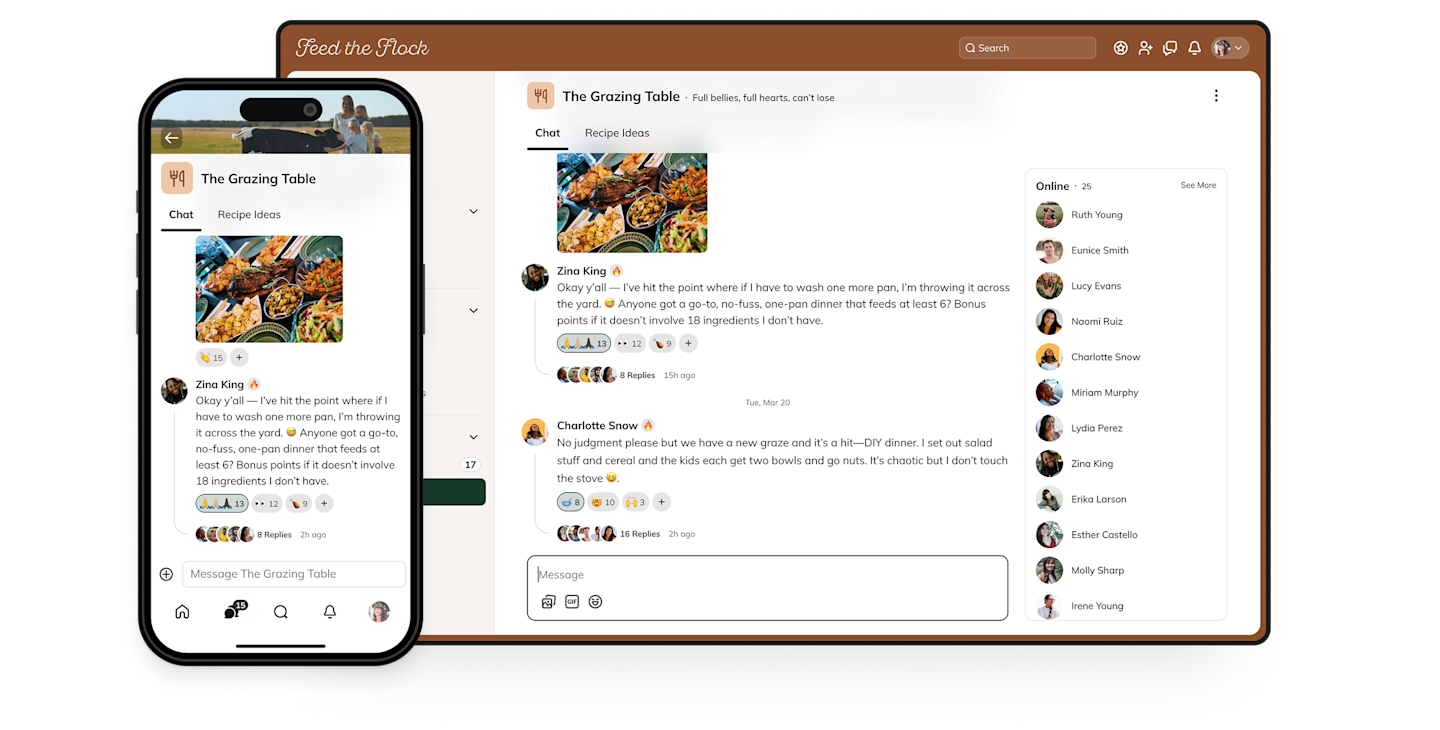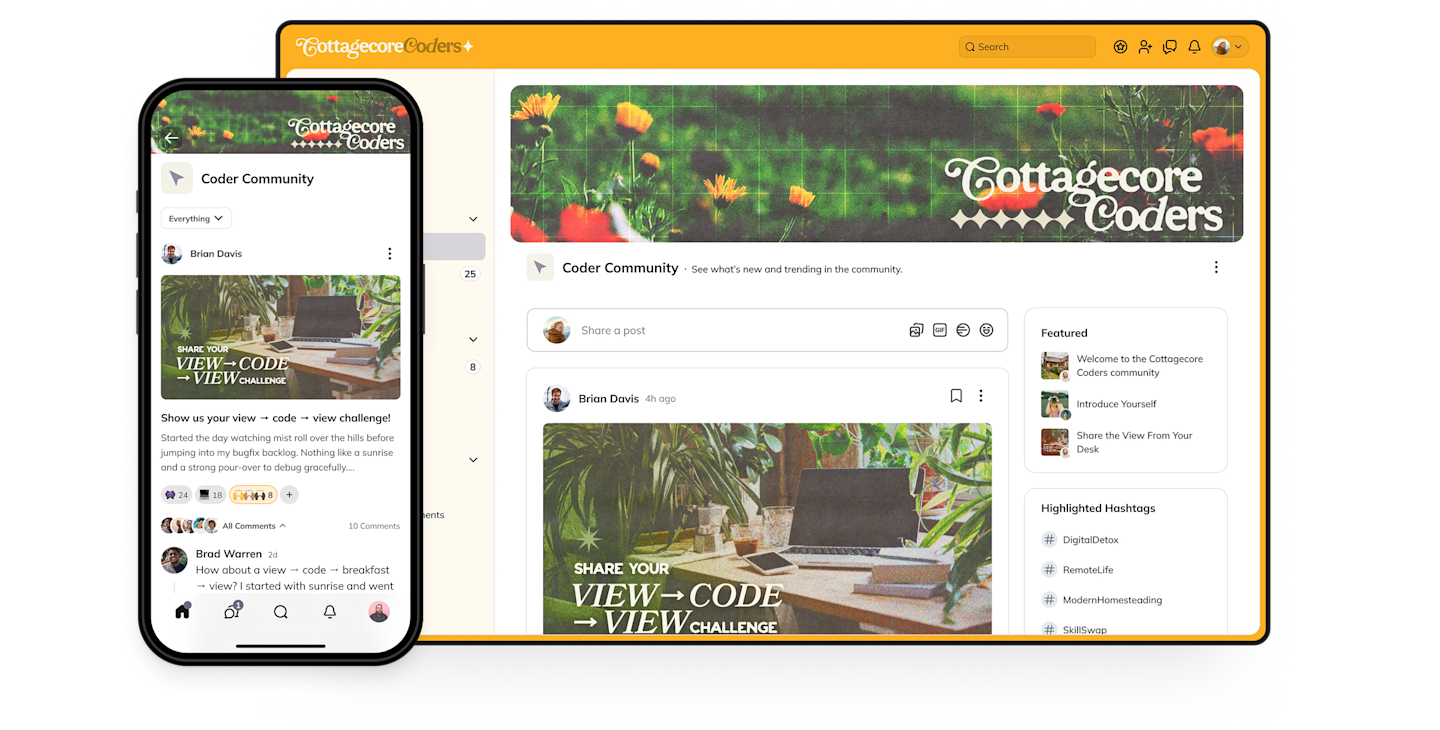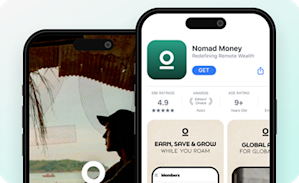Communities & Memberships
How to Create a Private Social Network in 5 Easy Steps
Many creators are looking for a way to build their own private community spaces. We have a step-by-step guide to help you do it.
Author
Mighty Team
Last Updated
July 30, 2025

Table of Contents
It’s no secret that social media has been the bread and butter for many creators looking to build an audience online. But as platforms like Facebook face endless questions around privacy, moderation, and more, there are a lot of people steadily looking for alternatives.
Private social network platforms have become a great option for creators looking to gain more control over their brand and build a deeper connection with and between their members. And since getting started can be a challenge, we’ve got you covered with the ins and outs of how to create a private social network.
Ahead, we’re going to break down step by step what you need to know to create a private social network. But first, let’s explore why these networks are great in the first place.
If you want more support in building your online community, come join OUR Mighty Community for free and meet other new and established community owners! We’d love to meet you. Join for free!
What is a private social network?
A private social network is an online community space that allows members to communicate and share information without posting on a public forum. The best private social networks will have many of the same tools and features that creators and members are used to from public social networks as well.

Why create a private social network?

But if we were to break it down a bit further, there’s one thing that sets private social networks apart from their public counterparts:
Control: Private social networking software puts the control back into creators’ hands. Meaning, they can determine how their network functions, create their own guidelines, and set their own rules.
Branding: Building on Facebook Groups, Twitter, and Instagram, also mean you're not building YOUR brand and/or brand identity. A private social network lets you do thi.
Monetization: It's really difficuly to monetize social media followers. A private social network improves your margins and puts monetization in YOUR hands.
Focus: Major social netoworks are BUILT for distractions. Heck, they only make money if they can distract your followers with ads. Membership-management software lets you eliminate these.
But with a private social network, creators, entrepreneurs, and small business owners have more options and control over each facet of their brand and content.

So, what does a private social network look like in action? Ahead, we explore how you can build one yourself in five steps.
Step 1: Define your goals
Your first step toward creating a private social network is to determine why you’re making one in the first place.
The answer might seem like it will be simple. Something like, “I want to grow my business” or “I want to make recurring income.”
Here are some questions to get you started:
What can’t I accomplish on my current platform that I could on a private one?
What roadblocks does my current platform cause for my community and how can building my own private social network remedy that?
How can creating a private social network better serve my members?
The clearer you are about what an online community is going to bring to you and your members, the better. And there’s no easier way to make your goals a reality once you start building your community than by writing them down upfront.
Step 2: Create your community’s Big Purpose
The second step you need to take to create a private social network is to clearly define what your community’s purpose is and why you can only accomplish it by making your own network.
Think of your community’s Big Purpose as the motivation behind your community. It’s something that can only be achieved if you bring together a specific set of people.

By the time you begin transitioning your community away from a public network to a private one, you will have already done all the research to know why it’s the right move. But that’s not the case for your members. So, you need to be able to articulate to them A. why this move is not only worth it and B. why what you’re trying to build can only be accomplished if you do.
Your Big Purpose should be specific, exciting, achievable only as a community, and provide rewarding results. It’s a key component to building a thriving private social media network, and it is absolutely worth the time to figure out. After all, when you’re able to clearly determine and communicate your big purpose, convincing your audience to move with you to a private social network gets a lot easier.
And no need to get stuck on this. With Mighty Co-Host™, our AI community generator can instantly create a perfect Big Purpose PLUS a community name and brand identity for you. Try it!
Try Our Community Name Generator
Our AI engine is here to help you create a community name that feels like magic. Just share a few words about who your community is for and we’ll get to work.
Examples: coaching clients, meditation novices, vegan chefs, dog lovers, aspiring entrepreneurs, etc.
The names generated by Mighty Co-Host™ are examples only and may be used by other businesses or subject to third-party rights. For more information, check our Terms
Step 3: Define your Ideal Member
After you’ve determined your motivation for transitioning to a private social network and worked out your big purpose, you’ll need to define your Ideal Member.
Your Ideal Member is the person who is going to be most excited and energized by your private social network. Think of them as your biggest supporter: Your Ideal members are the ones who you imagined would join your community when you started Building your big purpose.
Here are some things you can consider when determining your Ideal Member:
How old is my ideal member?
Why would my ideal member want a private network instead of a public one?
What has my ideal member been trying to accomplish that they can’t on their own?
Once you have a clear understanding of who your target audience is your job becomes much easier. Why? Because when you aren’t trying to target everyone you can better attract the people who will be most motivated by the journey you’re creating—and those are the people you’ll be able to give a truly great experience.

Step 4: Choose your platform
One of the most important steps in this process will be choosing a platform to create a private social network on.
If you’ve already done any research into the matter, there’s a good chance you’ve noticed that there are a lot of online community platforms out there. And a lot of them allow creators to build private networks.
When there are so many white label social network platforms out there, here's what you'll need:
an online community platform with powerful customization options.
a variety of ways to deliver content, and of course, easy-to-use community building tools.
a great mobile app experience akin to what your members are used to on public social networks.
If you’re curious what some of these tools and features might look like, here are a few we love:
A native mobile app experience available on iOS and Android devices.
Discussion boards, polls, Q&As, live and recorded video.
Member profiles and member data.
Direct messaging and subgroups.
Subscription options, virtual event hosting, livestreaming, and online courses.
That isn’t an exhaustive list, but it gives you an idea of the kinds of things you should be able to do with whatever private social networking software you choose.
Step 5: Invite people to your private social network
Once you’ve chosen the platform for your private social network, it’s time to finally tell everyone about the transition.
First and foremost, it’s important to acknowledge that if you’re moving an existing audience to a new platform, you will lose some members. But before you get scared off, we’re here to tell you that this is okay! Not everyone is going to be the perfect fit for what you’re building. And while you might lose a bit in numbers, you’re going to gain a lot more interactivity.

If you’re trying to build a community on a private social network from scratch, then don’t stress out about shooting for the stars right away. Tell the people in your life that you’re starting a community, they are much more likely to support you and tell them the world about the awesome things you’re doing.
Once you have a solid small group of people invested in what you’re building, you’ll begin to see more and more people join. We say this a lot, and we mean it: You only need 10 super motivated people to start. You can build from there.
Ready to start?
Right now is a great time to consider creating a private social network for your community. You will gain more control over your business and will be able to give more unique experiences to your members.

We’ve created a cultural software platform that lets you bring together community, courses, content, and commerce. It's easy to create your own network too. When you build with Mighty Networks you can sow the seeds for a thriving community because we’ve built a platform that grows with you and your members.
Mighty comes with flexible Spaces that let you mix and match courses, live events, live streaming, messaging, and written and video content.
Your community will be available anywhere thanks to our native mobile app support across iOS and Android devices.
You’re getting features to create online courses, charge for membership, and even host virtual events.
We allow creators to do more on our platform than anywhere else.
Let’s get started building your private social network together. Try Mighty free for 14 days!
Ready to start building your community?
Start a free 14-day trial to explore Mighty—no credit card required.
More like this
Join Mighty Community
Learn the principles of Community Design™ (and see them in action) alongside thousands of creators and entrepreneurs. It's free to join!

Online Courses
Creating a Course
Teaching a Course
Course Platforms
Selling a Course
Communities & Memberships
Community Platforms
Managing a Community
Building a Community
Growing a Community
Monetizing a Community
Content Creation
Creators & Entrepreneurs
Monetization
Content Creation
Starting a Business
Website Builders
Creating & Managing a Website
Events
Event Platforms
Hosting & Marketing Events
Branded Apps
Creating a Mobile App
Coaching Apps
Community Apps
Coaching
Mastermind Groups
Starting a Coaching Business
Coaching Platforms
Filter by Category
Online Courses
Communities & Memberships
Creators & Entrepreneurs
Events
Branded Apps
Coaching
Build a $1 Million Community
This free masterclass went viral—sign up to learn why.

























